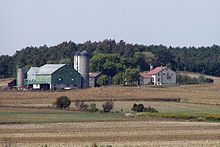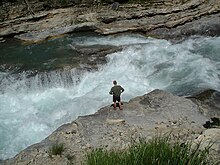Water resources
Water resources are sources of water that are useful or potentially useful to humans. It is important because it is needed for life to exist. Many uses of water include agricultural, industrial, household, recreational and environmental activities. Virtually all of these human uses require fresh water. Only 3% of water on the Earth is fresh water, and over two thirds of this is frozen in glaciers and polar ice caps. Water demand already exceeds supply in many parts of the world, and many more areas are expected to experience this imbalance in the near future. The framework for allocating water resources to water users (where such a framework exists) is known as water rights.
Water and Conflict
Water and resources have rarely been sources of conflict. This fact has lead security experts to ignore the relationship between water and security. There is in fact a long history related to water and conflict. The use of water systems as weapons is just on of them.
Sources of Fresh Water
Surface Water

Surface water is water in a river, lake or fresh water wetland. Surface water is naturally replenished by precipitation and naturally lost through discharge to the oceans, evaporation and sub-surface seepage.
Although the sole natural input to any surface water system is precipitation within its watershed, the total quantity of water in that system at any given time is also dependent on many other factors. These factors include storage capacity in lakes, wetlands and artificial reservoirs, the permeability of the soil beneath these storage bodies, the runoff characteristics of the land in the watershed, the timing of the precipitation and local evaporation rates. All of these factors also affect the proportions of water lost through discharge to the oceans, evaporation and sub-surface seepage.
Human activities can have a large impact on these factors. Humans often increase storage capacity by constructing reservoirs and decrease it by draining wetlands. Humans often increase runoff quantities and velocities by paving areas and channelizing stream flow.
The total quantity of water available at any given time is an important consideration. Some human water users have an intermittent need for water. For example, many farms require large quantities of water in the spring, and no water at all in the winter. To supply such a farm with water, a surface water system may require a large storage capacity to collect water throughout the year and release it in a short period of time. Other users have a continuous need for water, such as a power plant that requires water for cooling. To supply such a power plant with water, a surface water system only needs enough storage capacity to fill in when average stream flow is below the power plant's need.
Nevertheless, over the long term the average rate of precipitation within an watershed is the upper bound for average consumption of natural surface water from that watershed.
Natural surface water can be augmented by importing surface water from another watershed through a canal or pipeline. It can also be artificially augmented from any of the other sources listed here, however in practice the quantities are negligible. Humans can also cause surface water to be "lost" (i.e. become unusable) through pollution.
Sub-Surface Water
Sub-Surface water, or groundwater, is fresh water located in the pore space of soil and rocks. It is also water that is flowing within aquifers below the water table. Sometimes it is useful to make a distinction between sub-surface water that is closely associated with surface water and deep sub-surface water in an aquifer (sometimes called "fossil water").
Sub-surface water can be thought of in the same terms as surface water: inputs, outputs and storage. The critical difference is that for sub-surface water, storage is generally much larger compared to inputs than it is for surface water. This difference makes it easy for humans to use sub-surface water unsustainably for a long time without severe consequences. Nevertheless, over the long term the average rate of seepage above a sub-surface water source is the upper bound for average consumption of water from that source.
The natural input to sub-surface water is seepage from surface water. The natural outputs from sub-surface water are springs and seepage to the oceans.
If the surface water source is also subject to substantial evaporation, a sub-surface water source may become saline. This situation can occur naturally under endorheic bodies of water, or artificially under irrigated farmland. In coastal areas, human use of a sub-surface water source may cause the direction of seepage to ocean to reverse which can also cause salinization. Humans can also cause sub-surface water to be "lost" (i.e. become unusable) through pollution. Humans can increase the input to a sub-surface water source by building reservoirs or detention ponds.
Water in the ground are in sections called aquifers. Rain rolls down and comes into these. Normally an aquifer is near to the equilibrium in its water content. The water content of an aquifier normally depens on the grain sizes. This means that the rate of extraction may be limited by poor permiability.
Desalinization

Desalinization is an artificial process by which saline water (generally ocean water) is converted to fresh water. The most common desalinization processes are distillation and reverse osmosis. Desalinization is currently very expensive, and is only practical to generate water for household use in arid areas.
Frozen Water

Several schemes have been proposed to make use of icebergs as a water source, however to date this has only been done for novelty purposes. Glacier runoff is considered to be surface water.
Threats to Fresh Water
There are many things that are a threat to the Earths freash water supply. Here are a few of them.
Climate Change
Climate change will case changes to the water because there will be more rainfall in some parts and less in others. It would also causes major droughts during the summer. It also means that high tempratures and lower water flows provide the perfect growth conditions for a toxic algae which forms through the process of eutrophication. Climate change could also mean an increase in demand for farm irrigation, garden sprinklers and perhaps even swimming pools.
Depletion of Aquifiers
Since competition for water is growing, underground aquifiers are becoming depleted. This is mainly due to irrigation by groundwater. Millions of small pumps are currently taking water out of aquifers to irrigate crops. Irrigation in dry areas such as India is supplied by groundwater.
Pollution and Water Protection

Water pollution is one of the many concerns of the world today. World governments have strived to find solutions to eliminate this problem. One of these suggestions is the Kyoto Protocol. Many programs strive to protect our water resources. They are usually funded by donations from people who are generous.
Uses of Fresh Water
Uses of fresh water can be categorized as consumptive and non-consumptive (sometimes called "renewable"). A use of water is consumptive if that water is not immediately available for another use. Losses to sub-surface seepage and evaporation are considered consumptive, as is water incorporated into a product (such as farm produce). Water that can be treated and returned as surface water, such as sewage, is generally considered non-consumptive.
Agricultural

It is estimated that 70% of world-wide water use is for irrigation. In some areas of the world irrigation is necessary to grow any crop at all, in other areas it permits more profitable crops to be grown or enhances crop yield. Various irrigation methods involve different trade-offs between crop yield, water consumption and capital cost of equipment and structures. Another trade-off that is often insufficiently considered is salinization of sub-surface water.
Aquaculture is a small but growing agricultural use of water. Freshwater commercial fisheries may also be considered as agricultural uses of water, but have generally been assigned a lower priority than irrigation (see Aral Sea and Pyramid Lake).
Most people believe that irrigation wastes enormous quantities of water but if we be more efficient with irrigation, water would be made available for more than agriculture.
The first people who grew plants needed to learn three tasks. They were how to put specific plants in an area, how to prevent weeds from growing and how to make them flourish. How ever in dry climates plants needed water. Since most of the water was salt water, there had to be enough water to flush out the salt. In well drained areas flushing occurs naturally.
Industrial

It is estimated that 15% of world-wide water use is industrial. Major industrial users include power plants which use water for cooling or as a power source (i.e. hydroelectric plants), ore and oil refineries which use water in chemical processes, and manufacturing plants which use water as a solvent.
The portion of industrial water usage that is consumptive varies widely, but as a whole is lower than agricultural use.
Household

It is estimated that 15% of world-wide water use is for household purposes. These include drinking water, cleaning water, sewage and landscape irrigation. Landscape irrigation is a major concern because it can cause the flooding of residential basements.
Most household water is treated and returned to surface water systems, with the exception of water used for irrigation. Household water use is therefore less consumptive than agricultural or industrial uses.
Recreation

Water has alot of recreational value.
Recreational water use is a very small but growing percentage of total water use. Recreational water use is mostly tied to reservoirs. If a reservoir is kept fuller than it would otherwise be for recreation, then the water retained could be categorized as recreational usage. Release of water from a few reservoirs is also timed to enhance whitewater boating, which also could be considered a recreational usage. Other examples are anglers, water skiers, nature enthusiasts and swimmers.
Recreational usage is non-consumptive. However it may reduce the availability of water for other users at specific times and places. For example, water retained in a reservoir to allow boating in the late summer is not available to farmers during the spring planting season. Water released for whitewater rafting may not be available for hydroelectric generation during the time of peak electrical demand.
Environmental

Explicit environmental water use is also a very small but growing percentage of total water use. Environmental water usage includes artificial wetlands, artificial lakes intended to create wildlife habitat, fish ladders around dams, and water releases from reservoirs timed to help fish spawn.
Like recreational usage, environmental usage is non-consumptive but may reduce the availability of water for other users at specific times and places. For example, water release from a reservoir to help fish spawn may not be available to farms upstream.
World Water, Supply and Distribution
Food and water are two basic human needs. As the picture shows in 2025 much of the water will belong to the rich countries of the world and the poorer countries will suffer. By 2025 much of the worlds popualtion will live in urban and peri-urban areas.This means that the people and industries in these areas will be using a large share of the Earths water. Much of this water to supply these areas will come from irrigation.
Refrences/Sources
- Water Resources of the United States
- International Water Resources Association
- Canadian Water Resoures Association
- American Water Resoures Association
- Water Resource Research Center
- "Threats to water resources" by the Environment Agency
- Ancient Irrigation from the University of California, Geology Department
- Mining Water from the University of California, Geology Department
- The World's Water
- Uses for Water...
- Future Sources of Fresh Water
- World Water Supply and Demand: 1995 to 2025 from the International Water Management Institute
